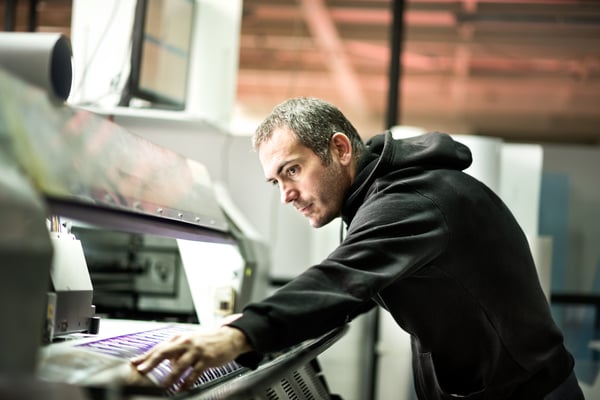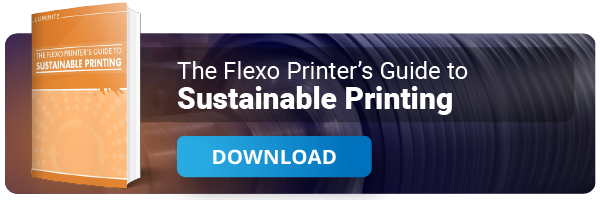Share this
Sustainable Printing Methods: Flexo vs. Screen, Gravure, Litho, Offset
by Luminite on Jan 24, 2022 6:00:00 AM

As the manufacturing society trends toward more eco-friendly practices, it’s important to consider whether or not you’re using sustainable printing methods.
Not only do you want to use sustainable materials like recyclable substrates and low-VOC inks, but you also want to optimize your pressroom to reduce waste.
So it begs the question, “Which printing method is the most sustainable?” Is it flexographic printing, or another method?
The Least Sustainable Printing Methods
The printing world has a wide array of printing methods for manufacturers to choose from, but that doesn’t mean all of them are ideal for a sustainable pressroom.
Some of the most popular printing methods are also, coincidentally, the least sustainable. Take, for example:
- Rotogravure printing
- Litho printing
- Screen printing
- Offset printing
Gravure Printing
Gravure printing is arguably the least sustainable printing method long-term.
Gravure requires metal cylinders to carry the ink, which is applied to recessed portions of the cylinders. The cylinders typically only carry one color, and the inks used through this process are highly solvent-based, creating harmful byproducts.
Litho Printing
While litho offers some more sustainable practices as far as materials used, the multistep process of litho creates a lot of extra effort into print runs. Requiring a transfer onto a liner board, litho is also incredibly limited in its applications.
Screen Printing
Screen printing is a valued printing method because of the vibrant colors it's capable of producing. Screen printing, however, is one of the least sustainable methods available for large-scale production.
Screen printing inks often contain harmful chemicals like phthalates that can easily leach out after the product cures. Screen printing produces toxic fumes, and nearly all materials used are non-recyclable hazardous waste.
As if that weren’t enough, reusing inks and screens is difficult. Though screen printing may give great results on some substrates, it’s the least sustainable way to produce large volumes.
Offset Printing
Offset printing is a form of indirect printing, using plates to transfer ink to a rubber cylinder called a blanket, which then transfers the ink to the substrate.
On the sustainability spectrum, offset printing falls somewhere in the middle. It requires more equipment, namely the blanket cylinder, and takes longer to set up. Plus, the inks used for offset are often oil-based, and the cylinders must be washed after every use. The oil-based inks often contaminate the water used to clean them.
The Most Sustainable Method: Flexography
Flexo has been repeatedly proven to be the most sustainable printing method. Flexo has the ability to easily print on pliable and flexible substrates, allowing the use of more sustainable and recyclable materials.
Flexo can accommodate water-based inks and methods like anilox laser cleaning to further reduce waste and water contamination.
Plus, by using elastomer blend sleeves, flexo saves the printer money. Gravure cylinders are extremely costly (and heavy) and are capable of about 50 million impressions before they need replacement. Elastomer sleeves aren’t capable of such a high impression count, but they are capable of being ground down, recovered, and re-engraved for a new image.
In the last ten years, the advancements in flexo printing equipment--everything from incorporating anti-bounce technology to AI solutions for ensuring quality prints-- have far surpassed the technological advancements of other printing methods.
Breaking Down Sustainable Printing Practices
Reusability and adaptability are key to having a sustainable printing operation. Methods like litho and gravure severely limit reusability, which can lead to huge storage and waste issues when more than one printing task is necessary.
A few other considerations go into what makes for sustainable printing practice, including:
- Inks
- Volatile organic compounds
- Energy consumption
- Image carrier material
Inks
Many inks contain harmful and toxic chemicals, leading to water contamination and harmful waste during production. Using sustainable inks decreases the footprint of your operation.
Once you print onto a substrate, that ink and substrate are connected and cannot be easily separated. As this bond slowly degrades during recycling and disposal, certain inks may prove to be harmful to consumers.
Volatile Organic Compounds (VOCs)
VOCs are harmful pollutants often resulting from the solvents in harsher inks. Litho printing tends to be pigeonholed into oil-based inks containing a plethora of harmful VOCs.
Using water-based inks is one of the best ways to cut down VOC footprint in a printing operation. Flexo can accommodate a large variety of inks to fit your needs, including water-based inks.
Energy Consumption
Though energy consumption level tends to balance out between processes, the secondary tasks associated with certain printing methods can massively change energy output. Thanks to digital technology, newer equipment uses less power than older equipment. This makes flexo particularly attractive.
Using air mandrels and quick changeover sleeve technology, paired with digital monitoring, flexo is able to run much more efficiently than alternatives.
Image Carrier Material
The materials you use also affect the sustainability of your printing operation. Flexo offers you unique flexibility in choosing more sustainable materials.
Decades ago, flexo sleeves were created with photopolymer, which offered cost-effective, high-quality printing. Today, silicone and elastomer sleeves offer similar image quality without the hazardous chemicals that come with photopolymer.
While many printing methods require the use of flat plates, flexo's in-the-round design avoids harmful washout. In-the-round solutions only has one tolerance to consider whereas flat plates have three different tolerances to align.
Plus, post-production cleaning flexo in-the-round sleeves is far more eco-friendly than other printing methods. Where plate production needs excessive amounts of water or chemicals for cleaning, elastomer sleeves require little more than a brush down and a rinse. Any small amount of harmful VOC waste is turned into smoke by thermal oxidizers and easily collected.
Sustainability for the Future
Though many printing methods offer little environmental sustainability, the most responsible methods of printing allow for easy reuse, leave a lighter energy and waste footprint, and accommodate the most sustainable inks and substrates.
There’s always a way to reduce your operation's footprint and improve sustainability.
To learn how to take your printing operation from mean to green, check out our sustainable printer’s guide!
Editor's Note: This blog post was originally published March 19, 2021 and was updated January 2022 to reflect updating information.
Share this
- Flexographic Printing (81)
- Image Carrier (28)
- Elastomer sleeves (27)
- Ink Transfer (25)
- Quality (22)
- Flexo sleeve (20)
- News (18)
- printing defects (18)
- flexo printing defects (17)
- sustainability (13)
- Flexo Troubleshooting (12)
- Ink (12)
- Digital Printing (10)
- Flexo 101 (10)
- Flexo Inks, (9)
- Anilox (7)
- Blister Packaging (7)
- Cost (6)
- print misregistration (6)
- regulations (6)
- Corrugated Printing (4)
- pinholing (4)
- "Tradeshow (3)
- Digital Flexo (3)
- Gravure Printing (3)
- Insider (3)
- Load-N-Lok (3)
- Wide Web (3)
- direct laser engraving (3)
- flexo-equipment-accessories (3)
- gear marks (3)
- halo (3)
- testing (3)
- Narrow Web (2)
- bridging (2)
- feathering (2)
- filling in (2)
- mottled image (2)
- pressure (2)
- Labelexpo (1)
- dirty prints (1)
- doughnuts (1)
- embossing (1)
- kiss impression (1)
- October 2023 (2)
- September 2023 (1)
- August 2023 (1)
- July 2023 (3)
- June 2023 (1)
- May 2023 (5)
- April 2023 (1)
- March 2023 (2)
- February 2023 (1)
- January 2023 (3)
- December 2022 (1)
- October 2022 (3)
- September 2022 (2)
- August 2022 (2)
- July 2022 (3)
- May 2022 (1)
- April 2022 (4)
- March 2022 (2)
- February 2022 (5)
- January 2022 (7)
- December 2021 (1)
- November 2021 (3)
- October 2021 (2)
- September 2021 (1)
- August 2021 (1)
- July 2021 (3)
- June 2021 (1)
- May 2021 (4)
- April 2021 (4)
- March 2021 (4)
- February 2021 (2)
- December 2020 (1)
- November 2020 (1)
- October 2020 (2)
- September 2020 (1)
- August 2020 (3)
- July 2020 (2)
- June 2020 (3)
- May 2020 (1)
- April 2020 (1)
- November 2019 (3)
- October 2019 (1)
- August 2019 (1)
- July 2019 (1)
- April 2019 (1)
- March 2019 (1)
- January 2019 (1)
- October 2018 (2)
- August 2018 (1)
- July 2018 (1)
- June 2018 (1)
- February 2018 (2)
- October 2017 (1)
- September 2017 (2)
- January 2016 (1)
- February 2015 (1)
- January 2015 (1)
- December 2014 (2)
- September 2014 (1)
- February 2014 (1)
- January 2014 (1)
- December 2013 (3)
- October 2013 (1)
- September 2013 (1)
- June 2013 (1)
- January 2013 (1)


Comments (3)